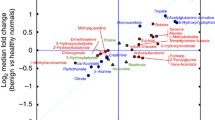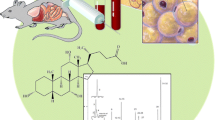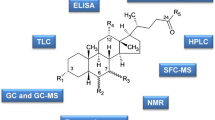Abstract
Objective
There are no specific biomarkers available for the definitive diagnosis of pancreatic cancer. Analysis of d-glucuronic acid (GlcUA) in bile could be valuable in this regard.
Materials and methods
Bile samples obtained from patients with pancreatic cancer (n = 4), chronic pancreatitis (n = 3) and control patients with biliary obstruction (n = 10) were analyzed by 1H NMR spectroscopy. GlcUA was quantified from the peak area of the α-1CH signal (at 5.24 ppm) obtained by deconvolution.
Results
GlcUA was detected in human bile by one-dimensional 1H NMR and two-dimensional 1H–1H COSY and TOCSY experiments. Quantification of GlcUA was achieved by measuring the peak area of the α-1CH signal using CPMG experiment, and the quantities of GlcUA were calibrated to account for the attenuation due to T 2 relaxation. GlcUA was observed at elevated levels in bile samples obtained from pancreatic cancer patients, whereas it was either absent or found in negligible amounts in control and chronic pancreatitis patients. The reason for the presence of elevated levels of GlcUA could be the hydrolysis of biliary bilirubin diglucuronide by β-glucuronidase, released excessively from pancreatic tissue during the course of malignancy.
Conclusion
Analysis of d-glucuronic acid in bile could be valuable in the detection of pancreatic cancer, and detecting GlcUA by in vivo 1H MRS has the potential to help in the non-invasive diagnosis of pancreatic cancer. Given that only four cancer patients have been studied so far, the new biomarker is regarded as a preliminary finding, but one that warrants further investigation.
Similar content being viewed by others
References
National Cancer Institute, Pancreatic Cancer. http://www.cancer.gov/cancertopics/types/pancreatic
Singh M, Maitra A (2007) Precursor lesions of pancreatic cancer. Molecular pathology and clinical implications. Pancreatology 7(1): 9–19
Jemal A, Siegel R, Ward E, Hao Y, Xu J, Murray T, Thun MJ (2008) Cancer statistics, 2008. CA Cancer J Clin 58(2): 71–96
Ghaneh P, Costello E, Neoptolemos JP (2007) Biology and management of pancreatic cancer. Gut 56(8): 1134–1152
Chari ST (2007) Detecting early pancreatic cancer: problems and prospects. Semin Oncol 34(4): 284–294
Louhimo J, Alfthan H, Stenman U, Haglund C (2004) Serum HCGβ and CA 72-4 are stronger prognostic factors than CEA, CA 19-9 and CA 242 in pancreatic cancer. Oncology 66(2): 126–131
Goggins M (2007) Identifying molecular markers for the early detection of pancreatic neoplasia. Semin Oncol 34(4): 303–310
Pepe MS, Etzioni R, Feng Z, Potter JD, Thompson ML, Thornquist M, Winglet M, Yasui Y (2001) Phases of biomarker development for early detection of cancer. J Natl Cancer Inst 93(14): 1054–1061
Canto MI, Goggins M, Hruban RH, Petersen GM, Giardiello FM, Yeo C, Fishman EK, Brune K, Axilbund J, Griffin C, Ali S, Richman J, Jagannath S, Kantsevoy SV, Kalloo AN (2006) Screening for early pancreatic neoplasia in high-risk individuals: a prospective controlled study. Clin Gastroenterol Hepatol 4(6): 766–781
Lattova E, Perreault H (2003) Labelling saccharides with phenylhydrazine for electrospray and matrix-assisted laser desorption-ionization mass spectroscopy. J Chromatogr B Analyt Technol Biomed Life Sci 793(1): 167–179
Lattova E, Kapkova P, Krokhin O, Perreault H (2006) Method for investigation of oligosaccharides from glycopeptides: direct determination of glycosylation sites in proteins. Anal Chem 78(9): 2977–2984
Analytical detection limit guidance http://www.dnr.state.wi.us/org/es/science/lc/OUTREACH/-Publications/LOD%20Guidance%20Document.pdf
Masyuk AI, Masyuk TV, Tietz PS, Splinter PL, LaRusso NF (2002) Intrahepatic bile ducts transport water in response to absorbed glucose. Am J Physiol Cell Physiol 283(3): C785–C791
Gruetter R, Garwood M, Ugurbil K, Seaquist ER (1996) Observation of resolved glucose signals in 1H NMR spectra of the human brain at 4 tesla. Magn Reson Med 36(1): 1–6
Nagana Gowda GA, Ijare OB, Somashekar BS, Sharma A, Kapoor VK, Khetrapal CL (2006) Single-step analysis of individual conjugated bile acids in human bile using 1H NMR spectroscopy. Lipids 41(6): 591–603
Khan SA, Cox IJ, Thillainayagam AV, Bansi DS, Thomas HC, Taylor-Robinson SD (2005) Proton and phosphorus-31 nuclear magnetic resonance spectroscopy of human bile in hepatopancreaticobiliary cancer. Eur J Gastroenterol Hepatol 17(7): 733–738
Albiin N, Smith ICP, Arnelo U, Lindberg B, Bergquist A, Dolenko B, Bryksina N, Bezabeh T (2008) Detection of cholangiocarcinoma with magnetic resonance spectroscopy of bile in patients with and without primary sclerosing cholangitis. Acta Radiol 49(8): 855–862
Ijare OB, Bezabeh T, Albiin N, Arnelo U, Bergquist A, Lindberg B, Smith ICP (2008) Absence of glycochenodeoxycholic acid (GCDCA) in human bile is an indication of cholestasis: a 1H MR study. NMR Biomed (in press)
Nelson DL, Cox MM (2000) Carbohydrate biosynthesis. In: Lehninger principles of biochemistry, 3rd edn. Worth, New York, pp 743–744
Gordon ER, Goresky CA, Chang TH, Perlin AS (1976) The isolation and characterization of bilirubin diglucuronide, the major bilirubin conjugate in dog and human bile. Biochem J 155(3): 477–486
Wu TW, Zumbulyadis N, Gross S, Gohlke RS (1980) Human conjugated bilirubin-isolation, biosynthesis, and direct molecular characterization. Clin Chem 26(9): 1323–1335
Sperker B, Werner U, Murdter TE, Tekkaya C, Fritz P, Wacke R, Adam U, Gerken M, Drewelow B, Kroemer HK (2000) Expression and function of β-glucuronidase in pancreatic cancer: potential role in drug targeting. Naunyn-Schmiedeberg’s Arch Pharmacol 362(2): 110–115
Prescot AP, Collins DJ, Leach MO, Dzik-Jurasz AS (2003) Human gallbladder bile: noninvasive investigation in vivo with single-voxel 1H MR spectroscopy. Radiology 229(2): 587–592
Kunnecke B, Bruns A, von Kienlin M (2007) Non-invasive analysis of gallbladder bile composition in cynomolgus monkeys using in vivo 1H magnetic resonance spectroscopy. Biochim Biophys Acta 1771(4): 544–549
Author information
Authors and Affiliations
Corresponding author
Rights and permissions
About this article
Cite this article
Bezabeh, T., Ijare, O.B., Albiin, N. et al. Detection and quantification of d-glucuronic acid in human bile using 1H NMR spectroscopy: relevance to the diagnosis of pancreatic cancer. Magn Reson Mater Phy 22, 267–275 (2009). https://doi.org/10.1007/s10334-009-0171-5
Received:
Revised:
Accepted:
Published:
Issue Date:
DOI: https://doi.org/10.1007/s10334-009-0171-5




